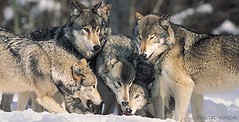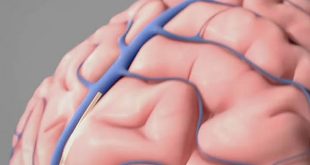The big bad wolf is back. Maybe he never went away, but for a while there he seemed to have achieved a form of rehabilitation. There were programs to reintroduce him to Yellowstone Park in Wyoming, and ensuring that pack numbers in the wild were maintained.
So it was something of a shock for me to read about the government of Alberta’s repeated culls of the wolf population. Wolves and ranchers out west have a long history of an adversarial relationship, with wolves being blamed for every single loss of livestock to predators.
Well, of course there is truth to that complaint, but what do you expect is going to happen when you destroy the habitat of a major predator’s prey, and offer it a smorgasbord that doesn’t have the brains to run away? If you were a wolf, what would you do? Go hungry or eat those stupid fluffy things that just bleat and don’t even fight back? That’s a real no-brainer as far I’m concerned.
It was proven that culling the pack in the neighbourhood where the attacks take place doesn’t reduce the amount of livestock that fall victim to wild attacks anyway. First of all, there are more than just wolves who are predators in this world, and secondly, you get rid of one pack, another will move in to take its place.
Anyway, that’s not even their excuse this time for killing off wolves. Nope, this time they’re trying to protect one herd of caribou that we’ve almost driven to extinction by our behaviour. The Alberta government is not satisfied with being able to boast a four billion dollar surplus, and continues trying to make more money through exploiting as much of the environment as they can to pump more natural gas.
As they push further out into the hinterlands and the tundra, they intrude more and more on the habitat of animals like the migratory herds of caribou. This was the main objection that environmental groups were raising to Bush’s plan for drilling in Alaska, that it would disrupt the caribou herds.
In a balanced ecosystem wolves play an important part in population control among prey animals. When you’re dealing with an animal as large as a caribou or an elk, most wolf packs are only going to take down the sick or the lame or the elderly, who wouldn’t survive anyway. A healthy adult caribou is not an easy take-down even for a pack; somebody is going to end up with their head caved in by a hoof or gored on an antler.
The herd in question has had its number reduced by loss of its habitat. Roads built into their territory have resulted in fatalities. The same birth defects that plague domestic stock where ranches are too close to drill sites prevent the herds from repopulating at a normal rate, and just the presence of humans in an area cuts into a herd’s potential grazing territory.
But instead of accepting that we could have had any role in the matter and cutting back on human intrusion into the situation, its been decided to blame it on our old enemy, the wolf. He’s such a handy villain, what would we do without him?
 Somewhere down the years, we humans have developed a mysterious, almost pathological fear of wolves. Maybe because they were the canines that told us to take a hike when we domesticated the species all those thousands of years ago, or maybe because we used to compete for the same prey, but whatever it is, no other predator has been more maligned throughout the history of Europe. (The coyote is a relative newcomer to that list, as Europeans didn’t encounter him until we showed up in North America.) Wolves have been pretty much wiped out in most places that they were native to in Europe, mainly due to the loss of habitat as man expanded and destroyed the living space for them and their prey. But there was also a deliberate attempt to destroy them out of superstition and fear.
Somewhere down the years, we humans have developed a mysterious, almost pathological fear of wolves. Maybe because they were the canines that told us to take a hike when we domesticated the species all those thousands of years ago, or maybe because we used to compete for the same prey, but whatever it is, no other predator has been more maligned throughout the history of Europe. (The coyote is a relative newcomer to that list, as Europeans didn’t encounter him until we showed up in North America.) Wolves have been pretty much wiped out in most places that they were native to in Europe, mainly due to the loss of habitat as man expanded and destroyed the living space for them and their prey. But there was also a deliberate attempt to destroy them out of superstition and fear.
Folklore and fairy tales have darkened the wolf’s image in the eyes of Europeans. Most of these depictions have come about through our assigning human attributes to animal behaviour. The National Wildlife Federation offers the examples of wolves being rarely seen in the wild being interpreted as secretive, hunting in packs as being sly, and howling as being evil.
Although the site doesn’t say this, it’s hard not to notice how the rise in fear and superstition about the wolf increased with the rise of Christianity. Prior to tenth century AD, wolves were not universally feared – in fact, they played prominent roles for good in mythology. Twin brothers, Romulus and Remus, who were saved from death by a mother wolf who suckled them as infants, founded the city of Rome, according to myth.
Other pre-Christian stories were also full of praise for the wolves, and the attributes that latter became evil were held in high esteem. Perhaps the demonising of the wolf was a deliberate ploy on the part of a new religion feeling insecure of its place in society and that needed to remove the competition. At any rate, the wolves’ reputation went to hell, so to speak, in the middle ages.
The reputation of being devil spawn and eaters of little blond girls and their grandmothers doesn’t do much for a creature’s popularity. It’s also something that travels well, especially when you come over to a new world, populated by savages living in deep mysterious forests. It was easy enough for settlers coming to North America to hold onto their beliefs of the wolf, if not being the devil incarnate, than at least a good buddy.
But you know what? In all the time Europeans have been in North America, there is not one verified account of a wild wolf attacking and killing a human. Cases in which people accuse wolves of such attacks are the result of wild dogs, and hybrids of dogs and coyotes (coydogs) that lack the fear of humans that wolves have.
Back in the 1950s, Canadian author Farley Mowat was working for the government in the wildlife department up north. He was sent out into the field to gain evidence to support a proposed policy to cull wolf populations because they were decimating the caribou herds and the large prey populations in general.
His discoveries, which were popularized in the book and movie Never Cry Wolf, did the opposite of what was wanted. He found, through observing the wolves, that their primary source of food was mice and other small prey animals. The only time that they would hunt the larger prey was when an animal was easy pickings, the sick and the elderly that the herds of deer, caribou or whatever were abandoning to their fate.
It just wasn’t worth the effort to track down and hunt a healthier animal, and they would take the easier way of feeding themselves by going after the lesser creatures that we consider pests. This of course goes a long way to answering the age-old question of “What purpose do they serve?”
Humans have this wonderfully selfish attitude of only seeing the world from their own point of view. An animal is judged based on what it does for humans, not on the fact that it is a part of the mystery known as creation. We don’t seem to want to accept that things haven’t been created solely for our benefit, but have a role to play that in the world that doesn’t take us into account.
The large predators of the world serve to keep prey populations in check so as to prevent the spread of disease and ensure the balance of a local ecosystem. Look at all the parts of North America where we have to have annual culls of the deer herds because they have no natural predators. Populations of deer in many states have become riddled with illness, like in Pennsylvania where the risk of Lyme disease is so high that it is a crime to touch deer that are road kill.
It’s become obvious that punishment of wolves is not a deterrent when it comes to protecting livestock and extermination is an unacceptable alternative, not just on tree-hugging moral grounds, but based on the key role they can play in keeping the population of pest animals under control. In fact farmers and ranchers could, if they work it right, put the wolves to use for them preserving their harvests and grain stores from rats and other so-called vermin.
What they need to do is develop systems of making their livestock less attractive as prey. Like in the case of the wolves observed by Farley Mowat, farmers and ranchers could make the effort involved not worth the payoff. In Ontario you can’t drive by a flock of sheep any more without seeing a donkey or two installed in the field with them. It turns out they make great guardians for the flocks. A couple of donkeys can fight off wolves and coyotes with ease.
It is important that we get over ourselves and learn how to co-exist with nature sooner rather than later. So far we’ve been able to prove that our current idea of dominance is not working out so well. Maybe for those who have been able to line their pockets and who don’t have any children it doesn’t matter what shape the world is in when they leave, but the rest of us might like to have some of the wild spaces preserved.
The most important lesson that we as a species need to learn is the one we can be taught by examining our relationship with the wolf. We can’t look on animals and impose human values, characteristics, or expectations. We can no longer continue to look upon any creature as separate, including ourselves.
The sooner we realize that all life is interconnected the better our chances of keeping the wild spaces alive and vibrant for all. What better place to start than with the wolf, to whom, of all creatures in the West, we owe the biggest apology. If after hundreds of years of animosity we can work out co-existence arrangements with them, it will be a huge step in the right direction.
 Blogcritics The critical lens on today's culture & entertainment
Blogcritics The critical lens on today's culture & entertainment



